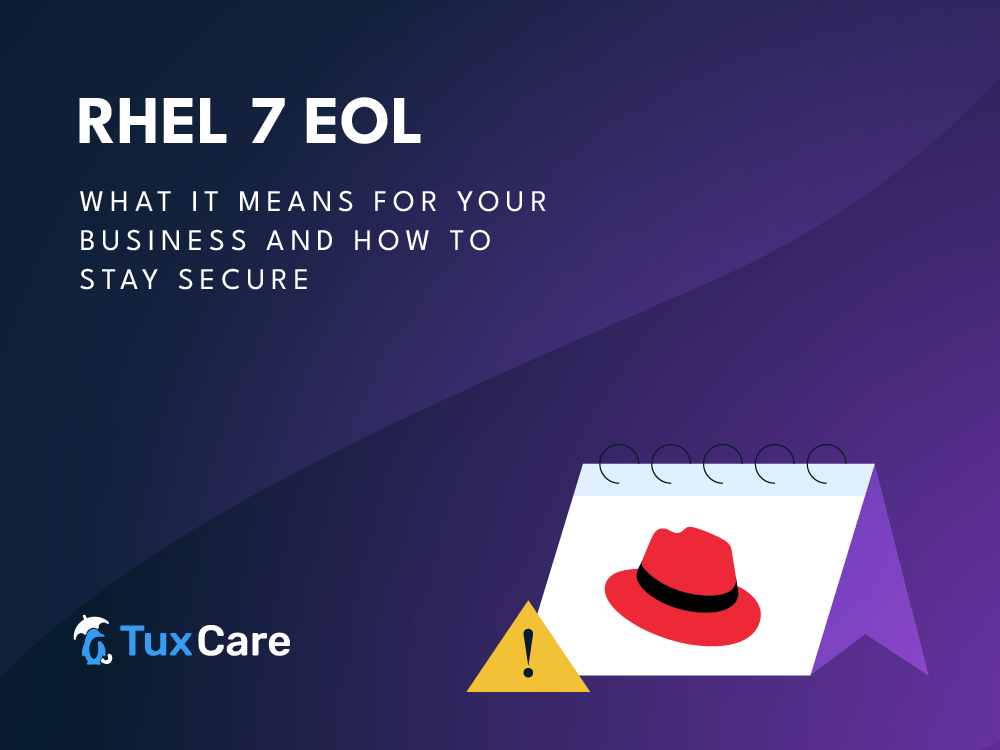- RHEL 7 reached its end of life on June 30, 2024, leaving systems exposed to security, compliance, and stability risks.
- Upgrading to RHEL 8 or 9 is complex and costly, and Red Hat’s ELS is both expensive and time-limited.
- TuxCare offers indefinite support for RHEL 7, with affordable pricing and industry-leading patching technology.
Red Hat Enterprise Linux 7 has served as a reliable foundation for enterprise IT environments for over a decade. But with RHEL 7 EOL now in effect, organizations still relying on this legacy OS are facing serious challenges – especially when it comes to security and compliance.
This blog post explores the impact of RHEL 7’s EOL on security and compliance, outlines the challenges of upgrading or relying on Red Hat’s limited Extended Life Cycle Support, and explains why TuxCare’s Endless Lifecycle Support is the most practical and cost-effective solution for securing your legacy systems long term.
The Real Risks of Running RHEL 7 Post-EOL
Since its EOL, Red Hat has stopped issuing security updates for RHEL 7 unless you’ve purchased their limited Extended Life Cycle Add-On. That means:
- Unpatched vulnerabilities accumulate over time, turning legacy systems into soft targets for attackers.
- Compliance violations become a serious concern for businesses in healthcare, finance, and other regulated industries.
- Operational risks increase with each passing day – potentially leading to costly outages or data breaches.
If your systems are still running RHEL 7, the risk is no longer theoretical. It’s real – and increasing by the month.
Your Options: Upgrade, Opt for Costly Support, or Stay Secure with TuxCare
In the wake of EOL, businesses are left with a few key options to maintain security and compliance:
Option 1: Upgrade to RHEL 8 or RHEL 9
Upgrading offers a fresh start, but also introduces new challenges:
- Extensive compatibility testing that can delay deployment.
- Risk of operational downtime during the transition.
- The need to retrain IT staff on the new environment.
- Potential hardware upgrades or virtual machine migrations.
Option 2: Red Hat’s Extended Life Cycle Support
While Red Hat does provide an extended life cycle option, it comes with several drawbacks:
- High cost, making it difficult for budget-conscious teams to justify.
- Limited timeframe, which only delays the need for a full upgrade.
- Lacks comprehensive coverage, potentially leaving critical CVEs unpatched.
Option 3: TuxCare’s Endless Lifecycle Support for RHEL 7
TuxCare offers a smarter solution:
- Indefinite security updates for RHEL 7, with no forced upgrade timelines.
- Accurate risk assessment with NIST CVE scores, unlike Red Hat, which often assigns lower severities that can miss critical threats in specific environments.
- Massive cost savings compared to Red Hat’s extended support.
- Simple setup with a one-line script to connect to TuxCare’s repository – no reboot required.
Don’t Let RHEL 7 EOL Put Your Business at Risk
Running RHEL 7 post-EOL without a solid support plan puts your business at serious risk. Security vulnerabilities, compliance issues, and unexpected downtime can all result in costly consequences.
TuxCare’s Endless Lifecycle Support delivers the security, flexibility, and cost-efficiency needed to keep your systems protected – on your schedule, not Red Hat’s.
Learn more about TuxCare’s RHEL 7 support to take control of your legacy systems today and ensure they remain secure, stable, and compliant for as long as you need.



 Documentation
Documentation Login
Login





